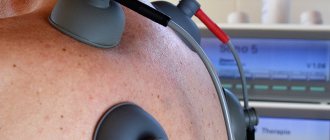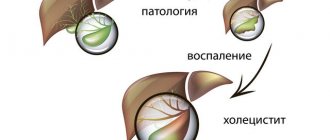Hemorrhoids are a vascular disease in which dilation of the hemorrhoidal veins of the rectum is observed, causing the formation of characteristic hemorrhoids that cause pain and bleeding in patients.
Diagnosis of hemorrhoids is not difficult: more than 90% of cases are determined during a digital examination of the anus and do not require the use of instrumental research methods.
Stages of hemorrhoids
There are 4 stages of hemorrhoidal disease:
- At the first stage, the symptoms of hemorrhoids, as a rule, are not so pronounced; they can occur periodically, for example, after hypothermia or after lifting heavy objects. Patients note discomfort and minor pain in the rectum, itching, a feeling of incomplete bowel movement, and occasionally the appearance of traces of blood on toilet paper after defecation. Hemorrhoids at this stage do not fall out and are located inside the rectum. It is at the first stage that this disease is easy to cure, but, unfortunately, patients rarely turn to a proctologist with such symptoms.
- At the next stage, these symptoms intensify. Hemorrhoids increase in size and feel like the presence of a foreign body in the rectum. Moreover, they may fall out during bowel movements. Bloody discharge becomes more abundant.
- The third stage is characterized by the fact that hemorrhoids fall out of the rectum with the slightest straining or straining and cannot be reduced on their own. Pain and bleeding become pronounced.
- At the fourth stage, the size of the hemorrhoids no longer interferes with the normal process of defecation, they constantly hurt and bleed.
Causes of the disease
Experts believe that the source of hemorrhoids is a change in local blood circulation due to weakening of muscles and veins. Provoking development factors include:
- food – spicy, salty, smoked, fried;
- bad habits – smoking, alcohol abuse;
- genetic predisposition;
- obesity and physical inactivity;
- hard physical labor;
- prostatitis, adenoma;
- liver pathologies, neoplasms;
- psycho-emotional stress.
Age-related changes also play a significant role in the occurrence of hemorrhoids.
Hemorrhoids in men and women
There is no difference between the clinical manifestations of hemorrhoids in men and women. Differences may lie in the causes of the disease. Pregnancy and childbirth increase the risk of developing hemorrhoids in women. During pregnancy, the uterus increases in size, puts pressure on the pelvic veins, and the tone of the vein walls decreases, leading to blood stagnation. The vessels in the rectum begin to dilate and this leads to the formation of hemorrhoids.
During the birth itself, intra-abdominal pressure increases, as a result of which the veins of the rectum become filled with blood and swell, and hemorrhoids may fall out.
Therefore, before planning a pregnancy, women are recommended to undergo a proctological examination in order to exclude or identify hemorrhoids at the initial stage and undergo a course of treatment. This will allow you to avoid unpleasant manifestations of the disease during such a wonderful period of life for any woman.
Men have their own risk factors for developing hemorrhoids. Men are more likely than women to engage in strength sports, and their work more often involves lifting weights. Loads significantly increase intra-abdominal pressure, and if the walls of the vessels of the rectal veins are weak, hemorrhoids may develop. Also, drinking strong alcoholic drinks provokes the development of hemorrhoidal disease.
If we talk about the differences between hemorrhoids in men and women, we can note that men are less likely to visit a proctologist in the initial stages and see a doctor when the disease is already advanced. This may be due to embarrassment, or because the man does not want to change his lifestyle, profession, or hobbies.
Diagnostics
Diagnosing hemorrhoids is not difficult. Among the studies are :
- How is surgery to remove hemorrhoids performed and what the consequences may be?
- physical and palpation examination;
- blood, stool and urine tests as differential diagnostics;
- sigmoidoscopy - endoscopic examination of the lumens of the rectal canal;
- Ultrasound of the abdominal organs.
If there is any doubt about the diagnosis, a colonoscopy is indicated - a large-scale endoscopic examination for diagnostic and therapeutic purposes, which allows one to examine almost the entire intestinal tract up to the duodenum. As the manipulation progresses, it is possible to remove nodes, polyps and other neoplasms, cure microcracks and stop bleeding. If necessary, gastroscopy is prescribed.
Hemorrhoids are the field of activity of proctologists , but consultation with a surgeon, anesthesiologist, oncologist, infectious disease specialist, or urologist may be required. Internal hemorrhoids must be differentiated from polypous neoplasms and other benign tumors, colorectal cancer, and inflammation of the rectum.
Is it necessary to treat stage 1 hemorrhoids?
To treat or not to treat hemorrhoids at stage 1 depends on the symptoms. If there is severe discomfort, itching, and blood appears during bowel movements, then it is necessary to treat. As a rule, treatment begins with the regulation of nutrition. To avoid constipation, you need to follow a diet: eat more fiber (fruits, vegetables, legumes, cereals) and maintain water balance; it is recommended to drink at least 2 liters of clean water per day. Next, conservative treatment of hemorrhoids may be prescribed - topical medications, physiotherapy. If conservative treatment has no effect, minimally invasive non-surgical methods are used.
If you were diagnosed with stage 1 hemorrhoids during a routine examination, or the symptoms are so minor that they do not cause discomfort, there is no bleeding, and you feel well, then there is no need for treatment. After all, as we wrote above, the treatment of stage 1 hemorrhoids is symptomatic. It is necessary to adjust the diet so as not to provoke constipation, and maintain physical activity.
The main problem is that, having discovered such symptoms as blood, pain, discomfort in the rectum, people themselves diagnose themselves with hemorrhoids and begin to self-medicate. This is absolutely not worth doing! Besides hemorrhoids, there are many other diseases with similar symptoms. Because of the fear of visiting a proctologist, you can even reach the fourth stage of hemorrhoids, not to mention more serious diseases. Only a doctor at an appointment can make a correct diagnosis. Believe me, in fact, a proctological examination in modern clinics is absolutely not a problem that you need to worry about. In medical diagnostics, diagnostics are carried out absolutely painlessly, using local anesthesia, in the most comfortable conditions for the patient. As for the treatment itself, several painless procedures may be required.
Take care of yourself, do not advance the disease, because treating hemorrhoids in the early stages is always easier and faster.
Conservative therapy
Treatment involves the use of local and oral medications. Almost all drugs have a complex spectrum of action; a specific type is selected by the doctor in accordance with the complexity of the pathological process and the general condition of the body.
Therapeutic procedures are carried out using:
- anticoagulants and antiplatelet agents - Gepatrombin, Geparoid Zentiva, Lyoton;
- hemostatic agents - Relifa, Troxevasin, Methyluracil, Troxerutin;
- venotonics - Indovazin, Aescin, Procto-Glivenol, Reparil, Venoruton, Essaven;
- anti-inflammatory - Doloproct, tetracycline and syntomycin ointment;
- hormonal - Proctosedyl, Ultraproct, Advantan, Aurobin, Hydrocortisol;
- immunomodulators – Posteinase, etc.;
- astringents - Bezornil, Proctosan;
- antiseptic - Levomekol, ichthyol ointment and Vishnevsky liniment.
Homeopathic medicines can be used during therapy: Aesculus, Phlebodia 600.
In addition to external agents, systemic venotonics may also be included in the regimen. Tablets are prescribed in the primary stages of pathology and as a means of preventing it. With their help, they get rid of venous stagnation, tissue swelling, and suppress the inflammatory process.
Systemic drugs are prescribed if the following indications exist:
- pain syndrome, bleeding;
- constipation - to soften fecal stones;
- the need to prevent the development of the disease or prevent the penetration of secondary infection.
Therapeutic procedures are carried out with Detralex, Venarus, Venoruton, Pilex, etc. During treatment, the patient must give up smoking and alcohol, switch to a balanced diet, not lift weights, and normalize the work and rest schedule.
What do specialist proctologists do?
Doctors at 7th Heaven do everything necessary to solve problems associated with anal diseases before they go too far.
We in no way replace our activities with the work of proctology departments of hospitals! The diseases of many patients who did not receive timely treatment can only be cured in a hospital bed in the proctology department of a hospital. Not only does each disease have a specific treatment, but each stage of the disease must have its own treatment method!
There are no universal treatment methods! But the treatment method should not be more severe than the disease itself.
Let us dwell on some specific issues that concern our patients.
How to get hemorrhoids in your youth
Why in our time do hemorrhoids sometimes occur at a very tender age? The most common causes of hemorrhoids in girls and boys:
- insufficient consumption of raw vegetables and fruits against the background of overeating processed meats, sweet fatty confectionery products, baked goods, fast foods;
- reduced intake of clean water into the body, which almost children still compensate for with sweet, concentrated carbonated drinks;
- the factor of inactivity, which arises from long-term sitting at the computer, provokes the development of stagnation of feces, intestinal atony, and insufficient emptying;
- sitting on the toilet for a long time, in an incorrect position, forces you to forcefully squeeze out condensed feces, due to the previously listed reasons. This leads to the appearance of microcracks, which are immediately infected by pathogenic microbes;
- colds resulting from recklessly following the “cries of fashion”: wearing short jackets with “fish” fur, trousers and skirts with low hips, exposing the back in the cold;
- hypothermia resulting from drinking alcoholic beverages, when young people do not react to the cold due to excessive “hotness”;
- in some cases, sexual promiscuity leads to lesions of the anus.
All causes of hemorrhoids , if desired, can be easily eliminated. It is the direct responsibility of parents and teachers to promptly tell young and foolish teenagers what terrible consequences hemorrhoids can lead to. This is thrombosis of hemorrhoidal vessels, leading to their necrosis, purulent complications - paraproctitis, anemia.
What is this anal fissure? How to deal with it? How is it dangerous?
To better understand the essence of the disease and how to treat it, we will take a short excursion into the anatomy of this area.
If we mentally examine the anus (anus) from the outside, we will see folds of skin radially converging towards the center. Nothing else! Anything else you might find shouldn't be there.
The anus is compressed by a muscle called the sphincter. Then the anal canal goes about 2-2.5 centimeters deep, covered with almost the same skin as the surface of the body. Only this skin is thinner and without hairs. It's called anoderm. The anal canal is one of the most sensitive places in our body.
Then the anal papillae are located deeper - small, papilloma-like formations. Their size ranges from 1-2 to 5-8 millimeters. And immediately behind them is the internal hemorrhoidal venous plexus, from which internal hemorrhoids are formed.
So, an anal fissure is a rupture of the skin (anoderma) inside the anal canal at a depth of 2-2.5 centimeters.
The sizes of anal fissures vary - from 5-6 millimeters to 2 centimeters. Of course, the larger the crack, the more it bothers its owner.
However, the “cute” thing about fissures is that small, sharp (i.e., fresh) anal fissures often don’t hurt. The pain appears after several weeks, or even months. During this time, the crack becomes chronic and the patient cannot cope with it on his own.
What is the cause of anal fissures? The most common is dense feces. Not even constipation! A small crack that causes slight discomfort after stool is the most typical onset of the disease. Unpleasant sensations quickly pass without drawing attention to themselves. But the crack remains! At this time, treatment is most relevant and effective. But who is being treated at this time?
How to treat?
The main principle of treating anal fissures is to achieve soft, non-traumatic stools. Often this factor alone is enough for the crack to heal. Various drugs that promote accelerated wound healing are very appropriate here.
“Why don’t you give ready-made recipes, doctor? You beat around the bush,” you say.
Yes, because, my dear patients, I am a categorical opponent of self-medication! By diagnosing yourself and prescribing treatment, you can reach a sad ending! At the same time, almost any disease detected at the beginning of its development is often treated quite simply and thoroughly.
As an example from life, I can tell you about an incident in a pharmacy. And you yourself, most likely, have encountered similar situations, and maybe participated in them.
I stood in a small line at the pharmacy. In front of me, a guy, about 25 years old, was literally extorting an ointment for “sores” from a male pharmacist. To the pharmacist’s credit, he resisted quite a bit, not wanting to sell the guy anything. I sent this patient to a dermatologist, citing the fact that sores can be very different. Of course, after all, a “sore” is a mosquito bite, an allergy, and syphilis - it also manifests itself as a rash! What kind of ointment is this?
Why am I writing this? And just so you know, there are different “sores”, including in the anus. Often they present with exactly the same symptoms, but are treated completely differently!
Well, have you taken a break from medicine? Now let's go back to the crack. To the form that is most often encountered at a proctologist’s appointment – chronic anal fissure. Unfortunately, untreated acute anal fissure eventually becomes chronic. And this time can vary from 1-2 to 3-4 months or more.
What are the features of chronic anal fissure?
- First of all, persistent pain that persists after stool from several minutes to several hours. This pain can be very severe and difficult to treat. It mostly goes away on its own over time until the next bowel movement, when it resumes again.
- The next difference is that the sphincter (the muscle that compresses the anus) contracts strongly - it goes into spasms. As a result of the spasm, the pain intensifies, conservative treatment becomes almost hopeless. Time has passed.
- Another very important feature of chronic cracks is the formation of scars along the edges (the body tries to heal the crack). These scars are another obstacle to treatment. With massive scars, the crack does not heal on its own; they must be removed.
- And finally, another feature of chronic anal fissure is the formation of sentinel tubercles (skin outgrowths similar to papillae). They come in different sizes - from a few millimeters to 1-2 centimeters and are located at the inner and outer edges of the anal fissure.
All these factors, individually or all together, make up the chronic anal fissure complex. Such a crack almost never heals with conservative (medicinal) treatment, even very carefully selected ones.
Imagine, the crack is only 1–2 centimeters, such a small sore, but how many important features it has!
Prices
Price (rub.)In installments* (rub.)Consultation with a surgeon on the operation (SPECIAL)0—Online doctor’s opinion on the operation (SPECIAL)0—Hemorrhoidectomy Cat. I. complexity from 35000—Non-surgical removal of hemorrhoids, category I. complexity from 3550—Coagulation of a hemorrhoid using radio wave surgery from 6400—Thrombosis of hemorrhoids (1 ligation) from 300—Thrombectomy from an external hemorrhoid from 4800—Removal of a thrombosed hemorrhoid I cat. complexityfrom 7800—Removal of a thrombosed hemorrhoid, category II. complexity from 9600—Removal of a thrombosed hemorrhoid, category III. complexityfrom 13750—See full list
Hide
* You can read more about the conditions here - Treatment on credit or in installments
The cost is preliminary. The exact cost of the operation can only be determined by a surgeon during a free consultation.
Why does the disease occur in the fair sex?
The causes of hemorrhoids in women are often the same as in young people, but with the addition of new factors.
- Hormonal imbalances during pregnancy lead to constipation. Thickened feces form microcracks as they move forward, causing severe pain, in response to which the body delays the process of defecation. At the same time, the discharge becomes even denser. The vicious circle can be broken with the help of special medications prescribed by a doctor, or folk remedies: eating beets, prunes. For normal metabolism, it is very important to drink as much clean water as possible, this stabilizes the body's water balance.
- During difficult childbirth, strong tension contributes to ruptures in the rectal mucosa, the formation of nodes, compactions, and inflammatory processes that cause the development of scars and adhesions that partially cover the width of the anus. To prevent undesirable consequences of hemorrhoids, it is important after childbirth to undergo examinations with a proctologist and gynecologist every six months.
- The reasons for the exacerbation of hemorrhoids may lie in diets that deplete the body, for example, separate meals. When some “healers” advise eating only uncooked buckwheat or eating more hot spices, which supposedly promote weight loss. In fact, poor nutrition and mucosal irritating additives are bad luck for the intestines.
Gentle, beneficial weight loss methods can only be recommended by a qualified nutritionist. Do not fall for the provocative advertisements of thick, colorful magazines. The advice published in them often has no scientific basis.








